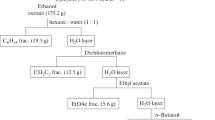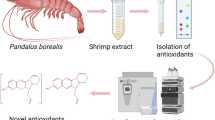Abstract
The composition of polyphenols in Kharkevich’s snakehead (Dracocephalum charkeviczii Prob., fam. Lamiaceae) of plants from a natural population and microplants obtained in vitro was determined. 15 polyphenolic components, mainly derivatives of caffeic acid, were determined in methanol extracts of plants by means of HPLC with UV and mass selective detection. As well as three glycosylated flavones—derivatives of acacetin (dihydroxy-methoxy-flavone) were among. The profiles of polyphenols in extracts of microplants and plants from the natural population were the same. The microplants were dominated by rosmarinic acid (63 μmol/g dry weight in the leaves, 11 μmol/g dry weight in the roots), caffeic acid (2 μmol/g in the roots), rhabdosin (8 μmol/g in the roots). In the roots of plants from the natural population, glycosylated rhabdosin prevailed (13 μmol/g dry weight in the form of a monoglycoside and 4 μmol/g dry weight in the form of a diclycoside).


Similar content being viewed by others
REFERENCES
Demain, A.L. and Fang, A., The natural functions of secondary metabolites, in History of Modern Biotechnology I, Adv. Biochem. Eng./Biotechnol., vol. 69, Fiechter, A., Ed., Berlin: Springer-Verlag, 2000, p. 1. https://doi.org/10.1007/3-540-44964-7_1
Bulgakov, V.P., Inyushkina, Y.V., and Fedoreyev, S., Rosmarinic acid and its derivatives: biotechnology and applications, Crit. Rev. Biotechnol., 2012, vol. 32, p. 203. https://doi.org/10.3109/07388551.2011.596804
Zeng, Q., Jin, H., Qin, J., Fu, J., Hu, X., Liu, J., Yan, L., and Zhang, W., Chemical constituents of plants from the genus Dracocephalum, Chem. Biodiversity, 2010, vol. 7, p. 1911. https://doi.org/10.1002/cbdv.200900188
Swarup, V., Ghosh, J., Ghosh, S., Saxena, A., and Basu, A., Antiviral and anti-inflammatory effects of rosmarinic acid in an experimental murine model of Japanese encephalitis, Antimicrob. Agents Chemother., 2007, vol. 51, p. 3367. https://doi.org/10.1128/AAC.00041-07
Anusuya, C. and Manoharan, S., Antitumor initiating potential of rosmarinic acid in 7,12-dimethylbenz(a)anthracene-induced hamster buccal pouch carcinogenesis, J. Environ. Pathol. Toxicol. Oncol., 2011, vol. 30, p. 199. https://doi.org/10.1615/JEnvironPatholToxicolOncol.v30.i3.30
Weremczuk-Jeżyna, I., Grzegorczyk-Karolak, I., Frydrych, B., Królicka, A., and Wysokińska, H., Hairy roots of Dracocephalum moldavica: rosmarinic acid content and antioxidant potential, Acta Physiol. Plant., 2013, vol. 35, p. 2095. https://doi.org/10.1007/s11738-013-1244-7
Trifan, A., Wolfram, E., Esslinger, N., Grubelnik, A., Skalicka-Woźniak, K., Minceva, M., and Luca, S.V., Globoidnan A, rabdosiin and globoidnan B as new phenolic markers in European-sourced comfrey (Symphytum officinale L.) root samples, Phytochem. Anal., 2020, p. 1. https://doi.org/10.1002/pca.2996
Fattahi, M., Nazeri, V., Torras-Claveria, L., Sefidkon, F., Cusido, R.M., Zamani, Z., and Palazon, J., A new biotechnological source of rosmarinic acid and surface flavonoids: hairy root cultures of Dracocephalum kotschyi Boiss, Ind. Crops Prod., 2013, vol. 50, p. 256. https://doi.org/10.1016/j.indcrop.2013.07.029
Winkel-Shirley, B., Biosynthesis of flavonoids and effects of stress, Curr. Opin. Plant Biol., 2002, vol. 5, p. 218.
Voronkova, N.M., Burkovskaya, E.V., Bezdeleva, T.A., and Burundukova, O.L., Morphological and biological features of plants related to their adaptation to coastal habitats, Russ. J. Ecol., 2008, vol. 39, p. 1. https://doi.org/10.1134/S1067413608010013
Kozhevnikov, A.E., Kozhevnikova, Z.V., Kwak, M., and Lee, B.Y., Illustrated Flora of the Primorsky Territory, Russian Far East, Incheon: Natl. Inst. Biol. Resour., 2019.
Probatova, N.S., Barkalov, V.Yu., and Nechaev, V.A., Chromosome numbers of vascular plants in Primorskii krai: prospective study, Uch. Zap. Zabaikal. Gos. Univ., Ser.: Estestv. Nauki, 2016, vol. 11, p. 27.
Butenko, R.G., Kul’tura izolirovannykh tkanei i fiziologiya morfogeneza rastenii (Culture of Isolated Tissues and Physiology of Plant Morphogenesis), Moscow: Nauka, 1964.
Bezdelev, A.B. and Bezdeleva, T.A., Zhiznennye formy semennykh rastenii rossiiskogo Dal’nego Vostoka (Life Forms of Seed Plants of Russian Far East), Vladivostok: Dal’nauka, 2006.
Murashige, T. and Skoog, F., A revised medium for rapid growth and bio-assays with tobacco tissue cultures, Physiol. Plant., 1962, vol. 15, p. 473.
Weremczuk-Jeżyna, I., Skała, E., Olszewska, M.A., Kiss, A.K., Balcerczak, E., Wysokińska, H., and Kicel, A., The identification and quantitative determination of rosmarinic acid and salvianolic acid B in hairy root cultures of Dracocephalum forrestii W.W. Smith, Ind. Crops Prod., 2016, vol. 91, p. 125. https://doi.org/10.1016/j.indcrop.2016.07.002
Weremczuk-Jeżyna, I., Kuźma, Ł., Kiss, A.K., and Grzegorczyk-Karolak, I., Effect of cytokinins on shoots proliferation and rosmarinic and salvianolic acid B production in shoot culture of Dracocephalum forrestii W.W. Smith, Acta Physiol. Plant., 2018, vol. 40, p. 1. https://doi.org/10.1007/s11738-018-2763-z
Clifford, M.N., Knight, S., and Kuhnert, N., Discriminating between the six isomers of dicaffeoylquinic acid by LC-MSn , J. Agric. Food Chem., 2005, vol. 53, p. 3821. https://doi.org/10.1021/jf050046h
Martínez-Vázquez, M., Estrada-Reyes, R., Martínez-Laurrabaquio, A., López-Rubalcava, C., and Heinze, G., Neuropharmacological study of Dracocephalum moldavica L. (Lamiaceae) in mice: sedative effect and chemical analysis of an aqueous extract, J. Ethnopharmacol., 2012, vol. 141, p. 908. https://doi.org/10.1016/j.jep.2012.03.028
Zhang, J.L., Yan, R.J., Yu, N., Zhang, X., Chen, D.J., Wu, T., and Xin, J.G., A new caffeic acid tetramer from the Dracocephalum moldavica L., Nat. Prod. Res., 2018, vol. 32, p. 370. https://doi.org/10.1080/14786419.2017.1359168
Weremczuk-Jeżyna, I., Skała, E., Kuźma, Ł., Kiss, A.K., and Grzegorczyk-Karolak, I., The effect of purine-type cytokinin on the proliferation and production of phenolic compounds in transformed shoots of Dracocephalum forrestii, J. Biotechnol., 2019, vol. 306, p. 125. https://doi.org/10.1016/j.jbiotec.2019.09.014
Fedoreyev, S.A., Veselova, M.V., Krivoschekova, O.E., Mischenko, N.P., Denisenko, V.A., Dmitrenok, P.S., Glazunov, V.P., Bulgakov, V.P., Tchernoded, G.K., and Zhuravlev, Y.N., Caffeic acid metabolites from Eritrichium sericeum cell cultures, Planta Med., 2005, vol. 71, p. 446. https://doi.org/10.1055/s-2005-864141
Goodwin, T.W. and Mercer, E.I., Introduction to Plant Biochemistry, Oxford: Pergamon, 1972.
Bulgakov, V.P., Vereshchagina, Y.V., and Veremeichik, G.N., Anticancer polyphenols from cultured plant cells: production and new bioengineering strategies, Curr. Med. Chem., 2017, vol. 24, p. 1. https://doi.org/10.2174/0929867324666170609080357
Janicsak, G., Mathe, I., Miklossy-Vari, V., and Blunden, G., Comparative studies of the rosmarinic and caffeic acid contents of Lamiaceae species, Biochem. Syst. Ecol., 1999, vol. 27, p. 733. https://doi.org/10.1016/S0305-1978(99)00007-1
Fattahi, M., Bonfill, M., Fattahi, B., Torras-Claveria, L., Sefidkon, F., Cusido, R.M., and Palazon, J., Secondary metabolites profiling of Dracocephalum kotschyi Boiss at three phenological stages using uni- and multivariate methods, J. Appl. Res. Med. Aromat. Plants, 2016, vol. 3, p. 177. https://doi.org/10.1016/j.jarmap.2016.04.002
Nosov, A.M., Functions of plant secondary metabolites in vivo and in vitro, Russ. J. Plant Physiol., 1994, vol. 41, p. 767.
Author information
Authors and Affiliations
Corresponding author
Ethics declarations
Conflict of interests. The authors declare that they have no conflicts of interest.
Statement on the welfare of humans or animals. This article does not contain any studies involving humans or animals performed by any of the authors.
Rights and permissions
About this article
Cite this article
Nakonechnaya, O.V., Gafitskaya, I.V., Grigorchuk, V.P. et al. Polyphenol Composition of Dracocephalum charkeviczii Prob. Plants in In Situ and In Vitro Conditions. Russ J Plant Physiol 69, 27 (2022). https://doi.org/10.1134/S1021443722010149
Received:
Revised:
Accepted:
Published:
DOI: https://doi.org/10.1134/S1021443722010149




